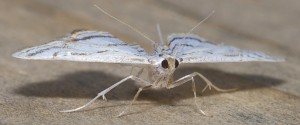
The object left deliberately undefined in the previous post is a trap nest, a small stick of wood with a pre-drilled hole designed for collecting wasps, especially potter wasps, hence the mudded up circle in the center. This particular nest was retrieved in November from the gaps in the cement blocks beneath our rain barrel. Last June, happening across several empty nests in the garage, I set the traps: two under cross braces on the garden fence, another beneath the rain barrel. Throughout the summer, whenever it occurred to look at them, they remained unused. That was ok…for I was preoccupied with other entomological endeavors, such as rearing bumblebees (not a success), journeying to Saskatchewan, or surveying local dragonfly populations. Mostly, while in the field on dragonfly business or busy in the backyard, I kept at my incidental collecting of adult wasps from flowerheads throughout the summer, a sideline occupation. Nevertheless, this non-methodical approach yielded a surprising variety of wasps.
In August, I ordered several redwood Schmitt boxes from the Bohart Entomology Museum at the University of California, Davis. These vintage insect boxes would be perfect for housing my small collection until it can be transferred to a curated collection at one of the local colleges. Before placing this order I browsed the used and antiquarian books the museum was offering for sale as a fundraiser. One caught my eye: Trap Nesting Wasps and Bees: Life Histories, Nests, and Associates by Karl V. Krombein (Smithsonian Press,1967).
In this book, Krombein (1912 – 2005) documents the contents of over 3,400 trap nests. It is certainly a classic of the study of Hymenoptera and I was lucky to find a copy. The arrival of this book and the storage boxes in the mail instantly rekindled my interest in trap nests. I set about preparing a number of new nests but almost simultaneously the weather turned cold and the season was over. So I’d have to wait until next summer. Read and wait.
I revisited the pages in Wasp Farm where Howard Ensign Evans discusses trap nesting. When I read this account some years ago, I followed the simple instructions and prepared a handful nests for my own use. These went unused for several years. I remember a couple of them sitting upright on a bookshelf, functioning as rustic vases, holding sprigs of bittersweet and a dried thistle flower. Then, during the summer of 2012, I finally got around to setting them out in a variety of places in the back yard, successfully collecting wasps from two of the nests.
While I have the specimens from the two nests, I didn’t gather all the data I might have. One nest was presplit, but when I opened it the larvae tumbled out and the information regarding their order in the nest was lost. These larvae were placed in vials where they pupated and, some weeks later, emerged as adults. Nor did I take note of the structure of the nest. And while the second nest was left intact for later examination, the examination never happened because the wasps emerged while in storage. The wasps in both nests, after graduating from translucent white larvae to opaque winged adults, were identified as Ancistrocerus antilope, a common, black-and-yellow potter wasp. There was, however, a single, bright metallic-blue exception…a cuckoo wasp (Chrysididae). This resplendent intruder, a kleptoparasite of cavity nesting wasps, had grown from a stealthily deposited egg, usurping one of the potter wasp’s cells and its provisions. The presence of both of these species in our backyard was surprising, for I’d never noticed either of them before.
Now, a little over a year later, I found my third occupied trap nest. It had been weeks since I’d seen a dragonfly and wasps were nearly the last thing on my mind when I happened upon the forgotten trap nest left in the blocks beneath the rain barrel. Finding it there and finding it occupied was a real treat, perhaps the year’s final entomological bonne trouvaille. Facing the cold winter months, the nest seemed a promise of the summer to follow.
Determined to document the contents of this nest properly (or at least better than the previous two), I consulted the methods section of Krombien’s book. When he retrieved nests from the field, he opened them, recorded the contents and structure of the nests, then closed them up again for overwintering and rearing. The wasps need to be reared to adults in order to be identified to species. Simple enough, right?
Well, the block of wood used for this particular trap nest contained a knot and splitting it turned out to be rather nerve-wracking, involving the violent touch of hammer and chisel. But eventually the grain grave up its grip and split, right along the bore-hole as planned, leaving the contents visible and intact. I took a quick photograph alongside a ruler for the records. Looking at the cells…the first cell had no larva, and appeared to be still filled with provisions. Perhaps the egg didn’t hatch or the larva had died. A closer look at the contents revealed a rather interesting drama within the already interesting drama of the nest itself. Details forthcoming in the next post…

Resources:
Evans, H. E. 1963. Wasp Farm. New York: Natural History Press, Doubleday.
Krombein, K.V. 1967. Trap-nesting wasps and bees: life histories, nests, and associates. Smithsonian Press, Washington D.C. vi + 570 pp.


